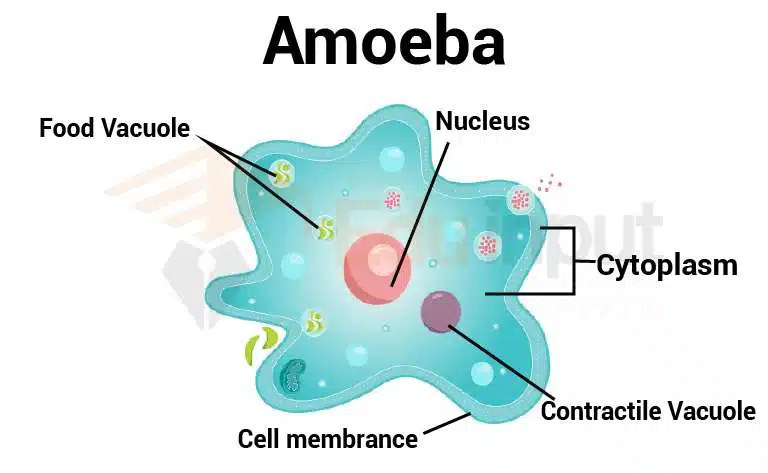Amoeba-Structure, Nutrition, and Habitat
Amoeba is a single-celled microorganism. It is a tiny microscopic creature that lives in freshwater. Though the body of Amoeba is formed of a single cell, the functioning of this cell is not so simple. Within the cell of Amoeba, many physiological functions like respiration, nutrition, reproduction, excretion, stimulation, etc. are performed.
Scientific Importance of Amoeba
The relative functions of the nucleus and the cytoplasm are determined using amoebas. Each amoeba has a small mass of jelly-like cytoplasm, which is differentiated into a thin outer plasm, a layer of stiff, clear ectoplasm, and a central endoplasm.
Structure of Amoeba
They are tiny single-cell creatures that live in ponds, rivers, and lakes. They are transparent and are visible only under a microscope. They do not have cell walls. Their body consists of a thin layer of a jelly-like substance called cytoplasm.
They have no bones, muscles, or nerves. They have no mouth, nose, ears, or eyes. They cannot see, hear, smell, taste, or feel. They reproduce by dividing themselves into two parts. One part remains alive, while the other dies.
They are classified as Eukarya because they have nuclei inside their cells. They have chromosomes, which are thread-like structures inside the nucleus. They have mitochondria, which produce energy for the cell.
They have ribosomes, which make proteins. They have DNA, which contains genetic information. They have RNA, which carries the genetic code. They have membranes, which separate the inside of the cell from the outside. They have food vacuoles, which store nutrients.

Nutrition and Food Digestion in Amoeba
There are food vacuoles, a granular nucleus, and a clear contractile vacuole at the end. The amoeba doesn’t have a mouth or anus, but it does have food and excretes it at any point on the cell surface.
During feeding, extensions of cytoplasm flow around food particles, surrounding them and forming a vacuole into which amylases are released to digest them. The amoeba then rids itself of the digested material by exocytosis.
Oxygen diffuses into the cell from the surrounding water, while the metabolism diffuses from the amoeba into the surrounding water. The contractile vacuole, which removes excess water from the amoeba, is not found in most marine and parasitic species.
Habitat Of Amoeba
Amoeba Proteus is often found in fairly clean ponds with highly oxygenized fresh water. It is often found in large “food webbed” ecosystems that contain many algae and plant life. Due to its adversity towards the light, it will usually seek shelter under anything that provides shade or dwell near the bottom of ponds.
This organism requires a moist environment to survive and has been observed to be attracted to grain products. The culture of Amoeba Proteus is relatively easy. By creating a pond-like environment with leaves, fresh water, mud, and perhaps a few wheat grains let the mixture sit for a couple of days. After a few days, specimens of Amoebae Proteus should begin to appear.
Amoebae Protexus can also be obtained by fermenting rotting organic material in pond water. Amoebae Proteus is found worldwide. It lives in ponds, rivers, and ‘other freshwater pools.
Soft wet soil, leaves, and stems of aquatic plants, or any hard surface may harbor Amoebae Protects, is a free-living animal that moves about by producing finger-like pseudopods. By producing these pseudopods, it moves and ingests its food.
Locomotion in Amoeba
They have a flagellum, which allows them to swim. They have a contractile vacuole, which expels waste products. They have a cytopharynx, which pumps water through the cell. They are motile, meaning they can move around. They can ingest bacteria, algae, and small
Reproduction in Amoeba
Amoeba reproduces asexually through binary fission. In this process, an individual divides itself into two daughter cells. These are genetically identical to each other.



Leave a Reply